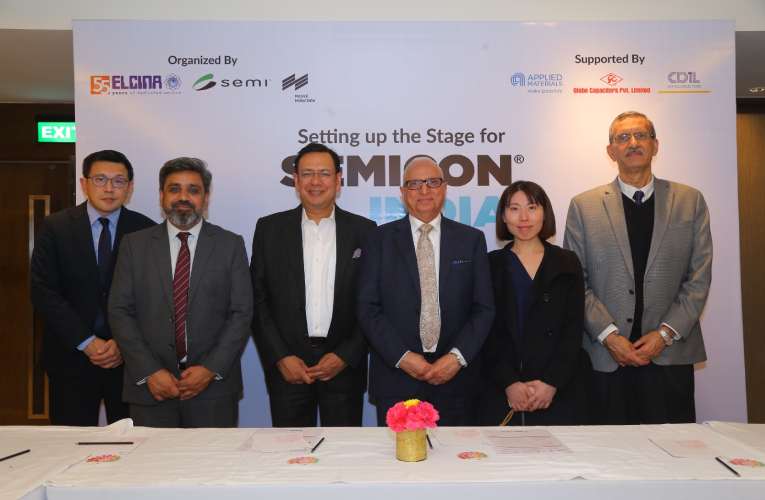
SEMI, the largest global Association for semiconductor eco-system and microelectronics has partnered with ELCINA & MMI, to support and Co-Organise SEMICON India 2024 which will be co-located with electronica & productronica India, organized by Messe Munchen India (MMI) from September 11-13, 2024, Greater Noida. This meeting was organized to bring all the stakeholders on one platform and collect different perspective.
Along with SEMI, ELCINA is working closely to focus on the supply chain and helping the country to become globally competitive in semiconductor manufacturing.
After the valedictory function of the 10th edition of the business meet in Gujarat, ELCINA organized an industry meet in New Delhi where Govt officials, Industry leaders, Academia and other stakeholders of the semiconductor eco-system gathered to discuss upcoming SEMICON 2024 event.
Sanjay Agarwal immediate past president ELCINA began the session by stating that the semiconductor industry has taken a center-stage in the electronics ecosystem of the country with the launch of India Semiconductor Mission. He said, “The government has put in place one of the most ambitious schemes of $10 billion to promote this industry. This is the right time for India to emerge as a semicon industry hub. Along with SEMI, ELCINA is working closely to focus on the supply chain and helping the country to become globally competitive in semiconductor manufacturing. This is a tremendous opportunity to surpass $55 billion by 2026.”
Ajit Manocha, President at SEMI said, “We are here to make history today. No company and business these days can survive without semiconductors. We have been working with Messe Muenchen India (MMI) closely to develop the ecosystem and with ELCINA, the foundation of manufacturing in the country. The common goal is to put India on the map of semiconductors. India can never reach the top spot of the economy without building the semiconductor ecosystem.”
Manocha said that SEMI along-with ELCINA, is looking forward to all stakeholders including industry associations to come together on this national mission and work jointly. All will be invited and are welcome. “In the coming few years, the digital economy will surpass $1 trillion figure. 109 wafer fabs have been announced globally, but it’s not enough to support the demand for semiconductors and we need another 50-100 fabs by the end 2026. I am extremely elated that ELCINA is closely working with the manufacturing companies to develop the industry and help them grow,” added Manocha.
S. K. Marwaha, CTO ISM, MeitY said, "With the unleashing of PLI schemes and India Semiconductor Mission, we have started giving incentives and subsidies to the companies. We started with developing the mobile ecosystem as it was in massive demand and then slowly started boosting the other sectors. We have signed ITA-1, but thankfully didn’t sign ITA-2 in 2015 which was a bold move by India. The government has started imposing import duty on certain items so that we can grow the domestic electronics industry and increase the capital expenditure by 20-25 percent. The target for $300 bn electronics by 2026-27 looks difficult, but it is achievable if all the industry leaders work closely.”
Going forward, Ajai Chowdhury, co-founder HCL and advisor to ISM opined, “It’s a great opportunity now for India to emerge as a global destination for semiconductor manufacturing. HCL started in UP and I am very supportive of the state. If we look at the past three years, the central government is very supportive of the policies. But, even if the policies are great, unless the combination of management, business plan, and technology partner is put together nicely, there will be difficulty in getting approvals from the central government. If we look at the current situation, hardly any industrial sector can survive without semiconductors. Very critically, India has to be in the semiconductor business, and I am very hopeful more companies will file applications to begin their operation in the country.”
Other industry leaders including among others, Mr. Manish Sharma, Panasonic; Dr Ashwini Agarwal, Applied Materials; Mr Inderdeep Singh, CDIL; Ms Bhavna Sethi, Micron Technology; Mr Varun Manwani, Sahasra Semiconductors; Mr Gagan Bansal, TDK; supported and gave their valuable inputs.
The speakers also added that the demand is driven by the growth in all the sectors, but the lion’s share goes to three sectors; smartphones, wearables, and automotive components. With an anticipated market share of more than 100 billion, the industry will provide more than 10,000 jobs. The Indian semiconductor ecosystem is going to contribute more than 1 billion dollars. Nazneen Akbari, Economic and Technology Advisor at the U.S. Department of State stated that a healthy resilient semiconductor ecosystem in India is an urgent need of the hour. More companies like Micron should invest in India as it is the growing hub for both chipsets and electronic products. The US and the rest of the world cannot be successful in this ecosystem, if India is not.
The event was supported by Applied Materials, Continental Device India Ltd and Globe Capacitors Pvt Ltd.

